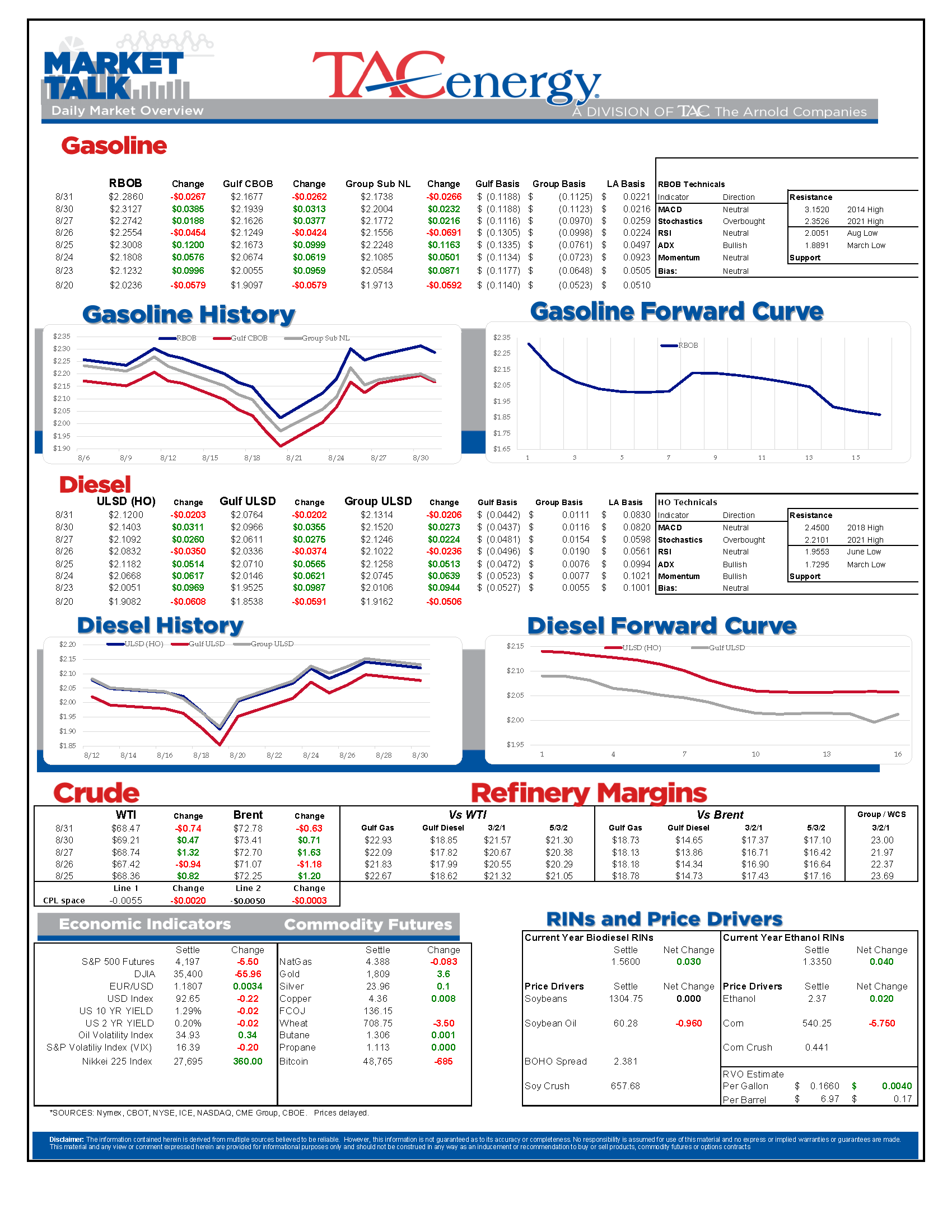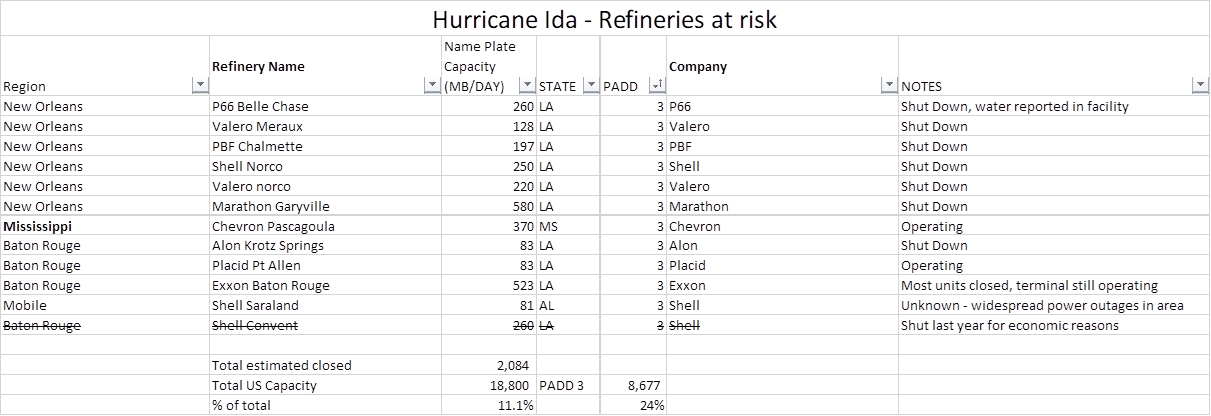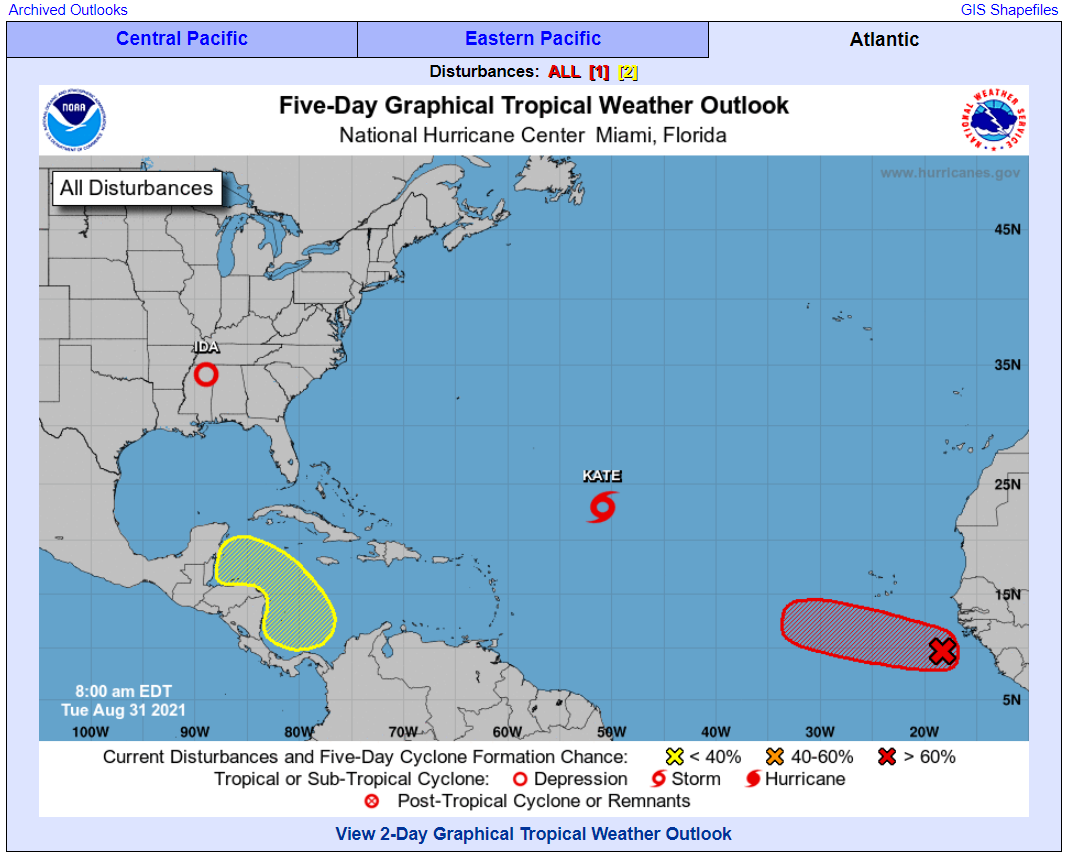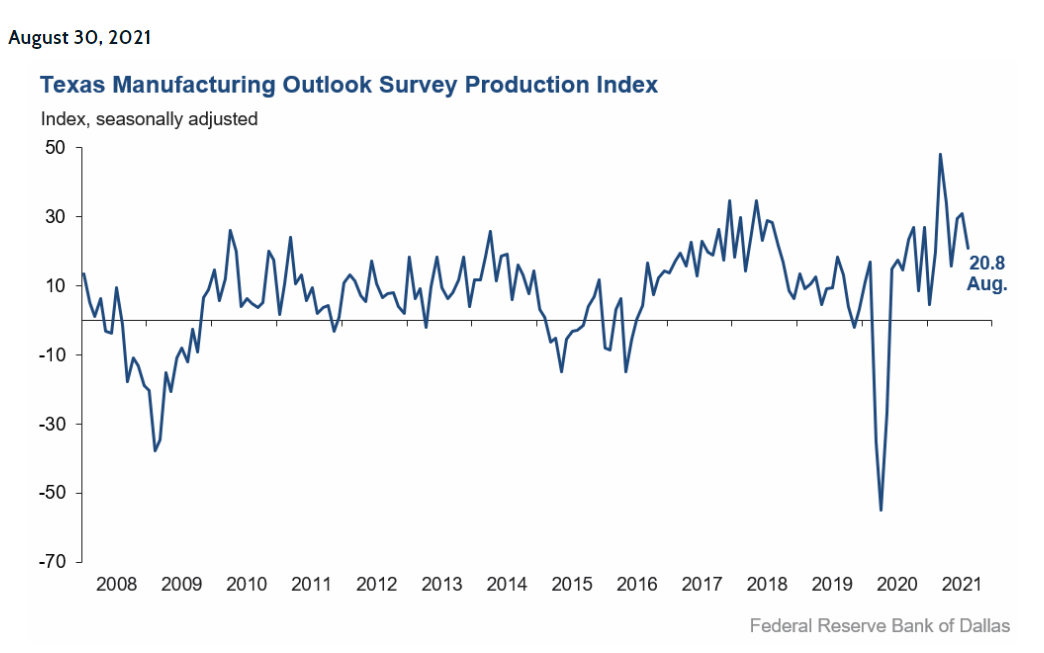Muted Reaction In Both Futures And Cash Markets

Energy futures are pulling back as August trading wraps up, with damage assessments along the Gulf Coast ongoing while the East Coast braces for another round of flooding rains as Ida moves north. While it will still take days to figure out the extent of the damage to one of the country’s largest oil hubs, the muted reaction in both futures and cash markets suggests the impact of this storm will not be widespread.
What a difference a decade makes: 2011 was the year the US became a net exporter of refined products for the first time since WWII. Prior to that, storms that made a direct hit on the country’s largest oil port, and 2nd largest refinery hub, would be expected to bring price spikes of $1/gallon or more. This time, gulf coast basis values barely flinched at one of the strongest storms to ever hit the Gulf Coast, even though it temporarily shuttered more than 10% of the country’s refining capacity and its largest pipeline, as the capacity to recover simply by not sending barrels to other countries has grown by millions of barrels/day.
Colonial pipeline did report that it was planning on restarting its 2 mainlines Monday night after a precautionary shutdown Sunday. The pipeline formerly known as Plantation, is still operating, but like most in the Baton Rouge area, is struggling with power outages that could end up forcing the need for the line to slow or shut. Exxon’s Baton Rouge refinery, a key origin point for the FKA Plantation pipeline, reported that it was forced to shut multiple units due to a lack of steady power and refinery inputs. Most of the other refineries that shut ahead of the storm have not yet made full damage assessments due to the widespread flooding and power issues. Early estimates are that most avoided major damage, but power supply will be the bottleneck determining how fast restarts can begin.
The EPA granted waiver requests allowing the sale of winter-grade gasoline (11.5lb rvp) 2 weeks earlier than normal in Mississippi and Louisiana to try and help alleviate any potential supply shortages. Pipelines were already just days away from starting to schedule winter grades, and the scope of the waiver is limited to just the 2 states so far, so it shouldn’t put downward pressure on prices elsewhere in the region.
While all eyes were focused on Ida, Tropical storm Julian came and went over the open Atlantic, and Tropical Storm Kate has also formed but looks like it will stay out to sea. Next up in the list for the year is Larry, and the NHC is giving 90% odds of a system moving off the coast of Africa getting that name later this week. That system is a good reminder that we’re now into the “Cabo Verde” portion of the Hurricane season where the systems moving off the African coast become more frequent, and form some of the most powerful storms we see each year, which is scary considering what we just saw from Ida that didn’t have nearly as much time to develop.
In non-storm news:
US equity indices reached fresh record highs (again) Monday, and are on pace for a 7th consecutive month of gains, just in time for the seasonal tick up in volatility.
Following up on a White House request, the FTC said that it is looking into whether or not retail station mergers and acquisitions is creating illegal activity in the way gasoline prices are set. It’s hard to say what, if any, changes this may bring about in the industry, but it certainly seems like it could slow down the rapid consolidation of retail station owners we’ve seen over the past several years.
The Dallas FED’s Texas Manufacturing Survey showed another month of expansion, but continued to highlight labor shortages and supply chain delays as major hurdles to continued growth.
Speaking of which, Bloomberg provides today’s interesting read: The race to recruit women to help fill the labor gap in the trucking industry.
Click here to download a PDF of today's TACenergy Market Talk.
Latest Posts
The Sell-Off Continues In Energy Markets, RBOB Gasoline Futures Are Now Down Nearly 13 Cents In The Past Two Days
Week 15 - US DOE Inventory Recap
Prices To Lease Space On Colonial’s Main Gasoline Line Continue To Rally This Week
Equity Markets Have Been Pulling Back Sharply In Recent Days As Inflation And Trade Concerns Inject A Sense Of Reality Into Stocks
Social Media
News & Views
View All
The Sell-Off Continues In Energy Markets, RBOB Gasoline Futures Are Now Down Nearly 13 Cents In The Past Two Days
The sell-off continues in energy markets. RBOB gasoline futures are now down nearly 13 cents in the past two days, and have fallen 16 cents from a week ago, leading to questions about whether or not we’ve seen the seasonal peak in gasoline prices. ULSD futures are also coming under heavy selling pressure, dropping 15 cents so far this week and are trading at their lowest level since January 3rd.
The drop on the weekly chart certainly takes away the upside momentum for gasoline that still favored a run at the $3 mark just a few days ago, but the longer term up-trend that helped propel a 90-cent increase since mid-December is still intact as long as prices stay above the $2.60 mark for the next week. If diesel prices break below $2.50 there’s a strong possibility that we see another 30 cent price drop in the next couple of weeks.
An unwind of long positions after Iran’s attack on Israel was swatted out of the sky without further escalation (so far anyway) and reports that Russia is resuming refinery runs, both seeming to be contributing factors to the sharp pullback in prices.
Along with the uncertainty about where the next attacks may or may not occur, and if they will have any meaningful impact on supply, come no shortage of rumors about potential SPR releases or how OPEC might respond to the crisis. The only thing that’s certain at this point, is that there’s much more spare capacity for both oil production and refining now than there was 2 years ago, which seems to be helping keep a lid on prices despite so much tension.
In addition, for those that remember the chaos in oil markets 50 years ago sparked by similar events in and around Israel, read this note from the NY Times on why things are different this time around.
The DOE’s weekly status report was largely ignored in the midst of the big sell-off Wednesday, with few noteworthy items in the report.
Diesel demand did see a strong recovery from last week’s throwaway figure that proves the vulnerability of the weekly estimates, particularly the week after a holiday, but that did nothing to slow the sell-off in ULSD futures.
Perhaps the biggest next of the week was that the agency made its seasonal changes to nameplate refining capacity as facilities emerged from their spring maintenance.
PADD 2 saw an increase of 36mb/day, and PADD 3 increased by 72mb/day, both of which set new records for regional capacity. PADD 5 meanwhile continued its slow-motion decline, losing another 30mb/day of capacity as California’s war of attrition against the industry continues. It’s worth noting that given the glacial pace of EIA reporting on the topic, we’re unlikely to see the impact of Rodeo’s conversion in the official numbers until next year.
Speaking of which, if you believe the PADD 5 diesel chart below that suggests the region is running out of the fuel, when in fact there’s an excess in most local markets, you haven’t been paying attention. Gasoline inventories on the West Coast however do appear consistent with reality as less refining output and a lack of resupply options both continue to create headaches for suppliers.

Week 15 - US DOE Inventory Recap

Prices To Lease Space On Colonial’s Main Gasoline Line Continue To Rally This Week
Energy markets are sliding lower again to start Wednesday’s trading as demand concerns and weaker stock markets around the world seem to be outweighing any supply concerns for the time being.
Rumors continue to swirl about an “imminent” response by Israel to Iran’s attacks, but so far, no news seems to be taken as good news in the hopes that further escalation can be avoided, even as tensions near the Red Sea and Strait of Hormuz continue to simmer.
Prices to lease space on Colonial’s main gasoline line continue to rally this week, trading north of 11 cents/gallon as Gulf Coast producers still struggle to find outlets for their production, despite a healthy export market. Gulf Coast CBOB is trading at discounts of around 34 cents to futures, while Gulf Coast RBOB is trading around a 16-cent discount, which gives shippers room to pay up for the linespace and still deliver into the East Coast markets at a profit.
Back to reality, or just the start of more volatility? California CARBOB basis values have dropped back to “only” 40 cent premiums to RBOB futures this week, as multiple flaring events at California refineries don’t appear to have impacted supply. The state has been an island for fuel supplies for many years as its boutique grades prevent imports from neighboring states, and now add the conversion of the P66 Rodeo refinery to renewable diesel production and the pending changes to try and cap refinery profits, and it’s easier to understand why these markets are increasingly vulnerable to supply shocks and price spikes on gasoline.
RIN prices continue to fall this week, touching 44 cents/RIN for D4 and D6 values Tuesday, their lowest level in 6 weeks and just about a nickel above a 4-year low. While the sharp drop in RIN and LCFS values has caused several biodiesel and Renewable Diesel producers to either shut down or limit production, the growth in RIN generation continues thanks to projects like the Rodeo refinery conversion, making the supply in RINs still outpace the demand set by the Renewable Fuel Standard by a wide margin.
The API reported draws in refined products, 2.5 million barrels for gasoline and 427,000 barrels for distillates, while crude oil stocks had an estimated build of more than 4 million barrels. The DOE’s weekly report is due out at its normal time this morning.
Click here to download a PDF of today's TACenergy Market Talk.




